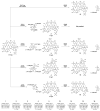Tailoring enzyme-rich environmental DNA clones: a source of enzymes for generating libraries of unnatural natural products
- PMID: 20945895
- PMCID: PMC3111151
- DOI: 10.1021/ja105825a
Tailoring enzyme-rich environmental DNA clones: a source of enzymes for generating libraries of unnatural natural products
Abstract
A detailed bioinformatics analysis of six glycopeptide biosynthetic gene clusters isolated from soil environmental DNA (eDNA) megalibraries indicates that a subset of these gene clusters contains collections of tailoring enzymes that are predicted to result in the production of new glycopeptide congeners. In particular, sulfotransferases appear in eDNA-derived gene clusters at a much higher frequency than would be predicted from the characterization of glycopeptides from cultured Actinomycetes . Enzymes found on tailoring-enzyme-rich eDNA clones associated with these six gene clusters were used to produce a series of new sulfated glycopeptide derivatives in both in vitro and in vivo derivatization studies. The derivatization of known natural products with eDNA-derived tailoring enzymes is likely to be a broadly applicable strategy for generating libraries of new natural product variants.
Figures





References
Publication types
MeSH terms
Substances
Grants and funding
LinkOut - more resources
Full Text Sources
Molecular Biology Databases

